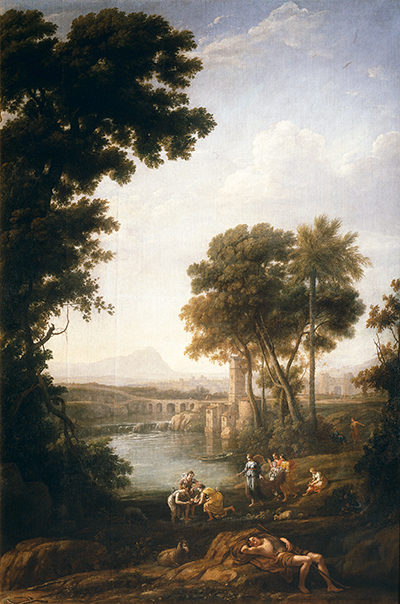Landscape with the Finding of Moses was completed by Claude Lorrain in around 1639–40. It was commissioned by Philip IV of Spain, one of many high status patrons acquired by the artist across his career.
This French artist regularly instilled religious and mythological themes into his landscape paintings, and in this example to be found at the Prado Museum in Madrid, Spain, he focuses on Moses’s rescue from the Nile by the Egyptian Pharaoh’s daughter. As is entirely typical for the artist, these elements are placed within a sprawling landscape which dominates your attention initially. A tall tree spreads across the vertical on the left hand side, whilst a road and bridge run across the horizontal space. A river deflects light around the painting from the centre of the composition and the sky behind is afforded nearly half the length of the canvas. The figures themselves are all to be found in the foreground, in a manner Claude used frequently. This adds an element of perspective and also provides an interesting contrast between man and nature, very much placing us as the servents of the stunning world around us. The style in which Claude incorporates these landscape elements remained fairly consistent throughout his career.
The artist understood that his talents lied in landscape painting, and not in figurative art. He practised his technical work in order to improve but eventually came to accept that figurative work should be kept to a minimum within his paintings. It is therefore no surprise that all of the figures included within Landscape with the Finding of Moses are relatively small, so that any issues would be harder to spot and the main focus would always be on the rest of the composition, which is where his artistic strengths would be delivered. Philip IV commissioned Claude to produce several paintings for his Buen Retiro Palace in Madrid, with the original artwork now found elsewhere in the city, at the famous Prado Museum. There may have been two sets of two for this commission, leaving four related paintings in total, though some historians have argued over which items were delivered together. Claude enjoyed an impressive list of patrons within Italy, where he lived for most of his life, but was an international artist who also found support from elsewhere once his reputation had been established.
The impressive Prado museum currently holds ten Claude Lorrain paintings in total within its permanent collection and these are mostly out on display all year round. The artist provides an interesting link between French, Spanish and Italian art, making him a great addition and also his connection to later landscape painting movements means he served an important role within the history of art. Other items to look out for here include River Ford, Landscape with Saint Mary of Cervelló, Landscape with Saint Onuphrius and The Embarkation of Saint Paula, with the institution having documented and researched each of these paintings in great detail, allowing us to really appreciate and understand every item within their impressive permanent collection. The venue remains a critical art venue within the city of Madrid and ranks favourably with other major art galleries right across the world.




